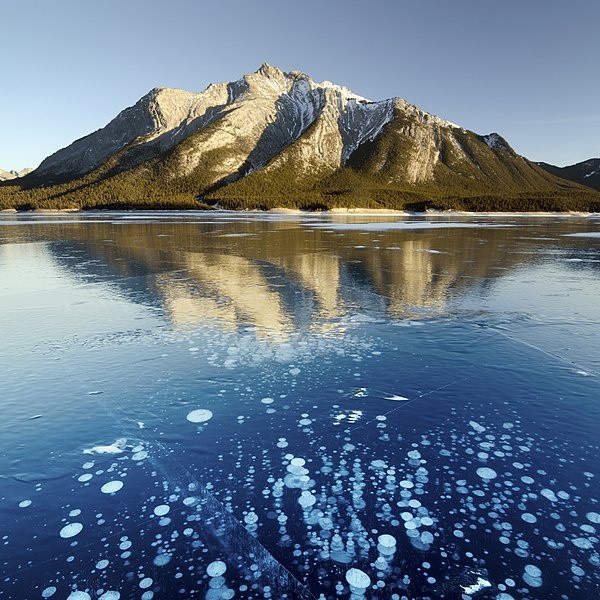Winter can produce astonishing works of art, such as the pockets of methane trapped in a frozen lake in Canada.

Ice Bubbles in Frozen Lake
During the wintertime, several tourists and photographers visit Lake Abraham in Alberta to witness an extraordinary natural phenomenon. On the eastern edge of the Rocky Mountains lies a reservoir which is known for its frozen bubbles.
The pockets of air dazzle when the turquoise water freezes and reveals thousands of white bubbles trapped below the surface. The icy spectacle of patterns and shapes is framed in deep cracks, milky ribbons of snow, and inverted walls of ice.
The best time to see the bubbles is from mid-January to early February since it is usually frozen by late December. After a few weeks, the bubbles were at their best since they had enough time to layer and freeze in thick ice.
There can be no guarantees when the lake will be frozen enough to safely walk on, since the freezing of the water depends on weather and temperature. If the temperatures have not been cold enough for a long period of time, Lake Abraham might not be frozen until mid-January.
The visibility of the bubbles could also be affected by snow. If there has been a recent snowfall, the frozen lake will be covered especially if there has been no significant amount of wind.
While Lake Abraham is unique from other lakes, it is also more dangerous since it is a man-made reservoir. Since the water level of the lake is controlled by a dam, it can rise and fall even after the formation of ice on top. The ice can also break more easily in the presence of an air gap between the ice and water.
READ ALSO : Melting Fire Ice Contributes to Climate Change; Hydrate Dissociation Spotted Due to Pockmarks
How Did the Methane Pockets Form?
The unique appearance of frozen bubbles in Lake Abraham might look like a product of a rare phenomenon, but they are actually just the result of the natural process of decomposition. The ice bubbles resulted when plants and tree limbs on the bottom of the lake started to decay. During this process, methane gas is released, which creates bubbles in the water. As the temperature drops during winter months, the methane bubbles get trapped in ice and become suspended just below the surface of the water.
As Lake Abraham continues to freeze, layers and stacks of bubbles begin to appear in the thickening ice. Soon, the lake appears like a giant lava lamp with icy bubbles frozen over time.
While all lakes naturally have organic matter decaying at the bottom, what makes Lake Abraham special is the clarity of ice and the high concentration of bubbles. The wind gusts in this area can be strong enough to blow off snow and polish the ice with a smooth, glass-like surface. As the blanket of snow is removed, thousands of frozen blobs are revealed.
Although a natural process produces the icy blobs, the encased bubbles contain dangerous greenhouse gas, which poses a threat to the planet. During spring, the ice thaws, and the bubbles pop, releasing the encased methane into the atmosphere. Since this gas is highly flammable, the bubbles can explode when set alight.
However, its real danger lies in its impact on the Earth's temperature. Although methane does not stay in the atmosphere like carbon dioxide, it has a heat-trapping effect that is 34 times stronger, making it far more dangerous to our climate.
Check out more news and information on Methane in Science Times.
© 2025 ScienceTimes.com All rights reserved. Do not reproduce without permission. The window to the world of Science Times.












